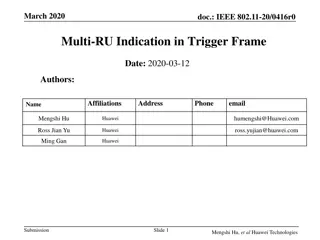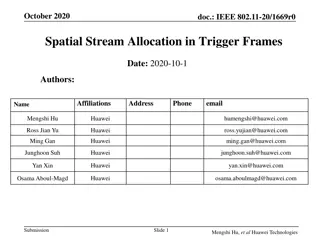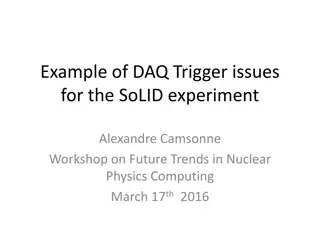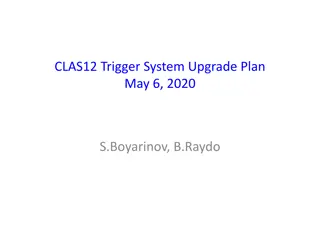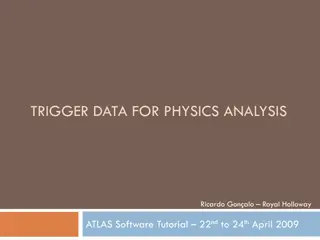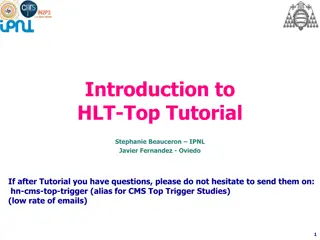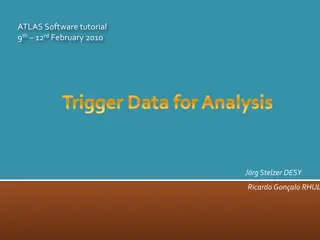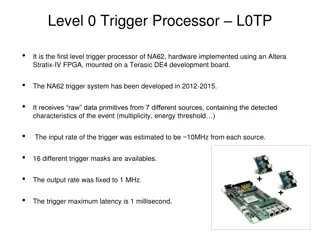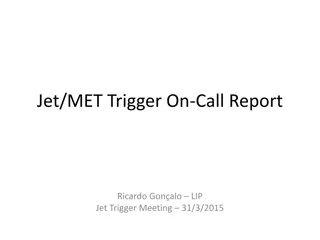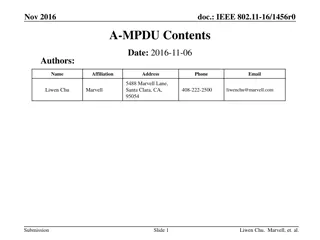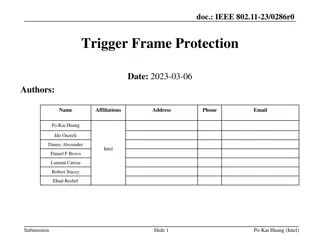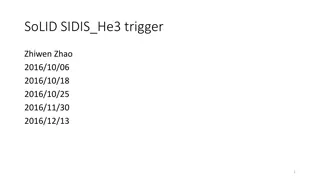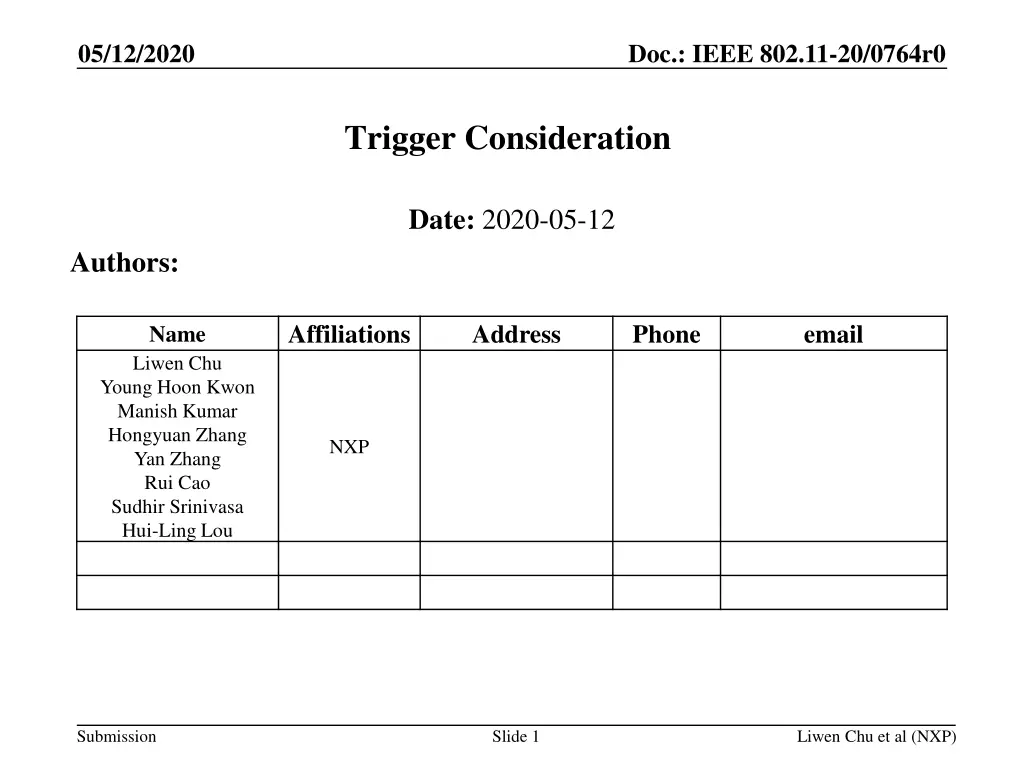
IEEE 802.11 Trigger Frame Design Analysis & Options
Explore the trigger frame design considerations in IEEE 802.11 standards, focusing on UL transmission solicitation for multiple STAs and support for wider bandwidths. Options like reusing trigger types and redefining common user fields are discussed for future 802.11 generations.
Download Presentation

Please find below an Image/Link to download the presentation.
The content on the website is provided AS IS for your information and personal use only. It may not be sold, licensed, or shared on other websites without obtaining consent from the author. If you encounter any issues during the download, it is possible that the publisher has removed the file from their server.
You are allowed to download the files provided on this website for personal or commercial use, subject to the condition that they are used lawfully. All files are the property of their respective owners.
The content on the website is provided AS IS for your information and personal use only. It may not be sold, licensed, or shared on other websites without obtaining consent from the author.
E N D
Presentation Transcript
05/12/2020 Doc.: IEEE 802.11-20/0764r0 Trigger Consideration Date: 2020-05-12 Authors: Affiliations Address Phone email Name Liwen Chu Young Hoon Kwon Manish Kumar Hongyuan Zhang Yan Zhang Rui Cao Sudhir Srinivasa Hui-Ling Lou NXP Submission Slide 1 Liwen Chu et al (NXP)
05/12/2020 Doc.: IEEE 802.11-20/0764r0 Recap: Triger Frame in 11ax, 11az Trigger frame is used to solicit UL transmission from multiple STAs. The UL PPDU type is fixed by Trigger Type. HE TB PPDU. Non-HT duplicated PPDU. Trigger frames will be used for EHT and the future 802.11 generations. Most UL multiple user transmission information are applied to various PPDU format. Trigger frame Common Info field User Info field Submission Slide 2 Liwen Chu et al (NXP)
05/12/2020 Doc.: IEEE 802.11-20/0764r0 Gap Analysis Wider BW will be supported in EHT and the future 802.11 standards. TB PPDU format that is different from HE TB PPDU will be used, e.g. EHT TB PPDU or the future TB PPDU. A STA can support the punctured operation where more than RU will be allocated to a single STA. Larger Nss is needed. Submission Slide 3 Liwen Chu et al (NXP)
05/12/2020 Doc.: IEEE 802.11-20/0764r0 Trigger Design Option 1 The Trigger Type (Basic, BFRP, BQRP, MU-BAR, MU-RTS etc.) is reused (Preferred method). The lengths of Common Info and User Info are kept same as 11ax. A User Info field with specific AID value (e.g. AID 2007, AID 2043) in AID12 field can announce a specific PPDU format, e.g. one of HE/EHT/future TB ( OFDMA or MU MIMO) PPDU formats and SU PPDU format. Other additional information can also be announced, e.g. the BW more than 160MHz, 20MHz Channel Bitmap that announce available 20MHz channel for puncture operation. The User Info fields follow it will use the announced specific OFDMA (MU MIMO) format until a new OFDMA(MU MIMO) format is announced. The HE OFDMA format can be announced explicitly or can be announced by default, e.g. the User Info fields immediately following the Common User Info field without OFDMA format announcement. Optional Padding User Info 4 User Info 3 User Info 7 FCS MAC header User Info 2 User Info 6 User Info 5 User Info 1 Common Info NG_EHT OFDMA UL HE OFDMA UL EHT MU MUMIMO User Info to announce new MU format, e.g. NG_EHT OFDMA User Info to announce new MU format, e.g. EHT MU MIMO. User Info 4 Optional Padding User Info 3 User Info 7 FCS User Info 0 MAC header User Info 2 User Info 6 User Info 5 User Info 1 Common Info NG_EHT OFDMA UL HE OFDMA UL EHT MU MUMIMO User Info to announce new MU format, e.g. NG_EHT OFDMA/MU_MIMO User Info to announce new MU format, e.g. EHT OFDMA/MU_MIMO. Slide 4 User Info to announce HE OFDMA/MU-MIMO. Submission Liwen Chu et al (NXP)
05/12/2020 Doc.: IEEE 802.11-20/0764r0 Solution 2: Redefining Field in Common User The Trigger Type (Basic, BFRP, BQRP, MU-BAR, MU-RTS etc.) is reused. The lengths of Common Info and User Info are kept same as 11ax. UL HE SIG-A2 Reserved is redefined to carry the information for EHT STAs and the STAs of next generation of EHT (EHT-NG STAs). The UL HE SIG-A2 indicates the redesigned B54 to B52 of the Common Info field, e.g. one bit (for example B54 as Further Common Info Indication field) is always set to 0 for such purpose. The other fields in Common Info field are not changed. The Further Common Info (B55 to B62) can indicate: the TB PPDU type, e.g. EHT PPDU, EHT-NG TB PPDU etc. One exception is that MU-RTS still solicit non-HT duplicated CTS in static punctured channel, dynamic punctured channel, or non-punctured channel The Additional BW Indication, e.g. 320/160+160 etc. The 320/160+160 may be indicated by other place instead, e.g. by B63. Other common information. The lengths of the other subfields in Common Info are not changed. User Info field EHT Trigger frame Common Info field B62 B54 B55 Further Common Info Indication(=0) Further Common Info Submission Slide 5 Liwen Chu et al (NXP)
05/12/2020 Doc.: IEEE 802.11-20/0764r0 Trigger Design Option 3 The EHT TB PPDU and future are defined through new Trigger type, e.g.: New Trigger frame type through Trigger Dependent Common Info indicates that the AP solicits an EHT TB PPDU. A Trigger type indicates the EHT Trigger which includes the Trigger Depended Common Info. New Trigger Control frame through the new Control subtype indicates that the AP solicits an EHT TB PPDU and the future generations of TB PPDU. Common User, TB Type Dependent Common Info, TB Type Dependent User Info can be redefined to support >160MHz BW, new TB PPDU format, punctured RUs etc. Common Info includes the information for all solicited TB types: 4-bit Trigger Type (indicating the trigger extension), 4-bit Extended Trigger Subtype (variants under trigger extension): Extended Basic Trigger, enhanced BFRP, enhanced MU-BAR, enhanced MU-RTS, enhanced BSRP, enhanced BQRP, enhanced NFRP. 12-bit UL Length (same as 11ax), 1-bit CS Required (same as 11ax), 3-bit UL BW, One embodiment is that this field is in Common Info for Specific TB Type. 6-bit AP Tx Power (same as 11ax), Other common Info fields. Submission Slide 6 Liwen Chu et al (NXP)
05/12/2020 Doc.: IEEE 802.11-20/0764r0 RU and Nss Consideration Additional bit in User Info field may be required for RU Allocation. Additional two bits are for >8 SS support in Basic Trigger. It is reasonable to assume that >8 SS only occurs in Basic Trigger case. One available bit in Basic Trigger One available bit here Submission Slide 7 Liwen Chu et al (NXP)
05/12/2020 Doc.: IEEE 802.11-20/0764r0 Multiple RUs for Single STA Method 1 The punctured RUs for a STA is identified by one RU Allocation value (Preferred method). No more than one User Info field in the Trigger frame being will be addressed to a STA. The current Trigger parsing is less changed. The RU lookup table become bigger. Submission Slide 8 Liwen Chu et al (NXP)
05/12/2020 Doc.: IEEE 802.11-20/0764r0 Multiple RUs for Single STA Method 2 Multiple User Info fields are allocated to single STA where the multiple User Info fields have same values in their AID12 fields. The multiple User Info fields with same AID12 field value are not separated by User Info fields for other STAs in Trigger frame. An option could be that one bit in User Info field indicates whether the User Info field is the only or last User Info field for a STA. More change to the current Trigger parsing is needed. The RU lookup table is smaller. Submission Slide 9 Liwen Chu et al (NXP)



